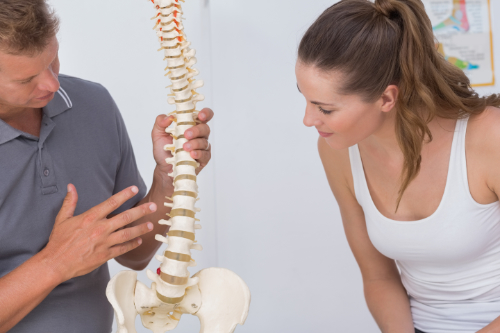Three Abnormalities of the Spine that Benefit from Consistent Chiropractic Care
3 Abnormalities of the Spine that Benefit from Consistent Chiropractic Care
The spine are comprised of vertebrae, small bones that are stacked on top of each other with impact cushioning discs between each one. These bones act as joints, allowing the spine to bend and twist in a variety of ways. However, it is not intended to be naturally bent, twisted, or curved. The natural state of a healthy spine is somewhat straight with slight curves running front to back so that a side view would reveal them. They gently curve, sloping slightly inward at the small of the back, and again slightly at the neck. The pull of gravity, combined with body movement, can put a great deal of stress on the spine and these slight curves help absorb some of the impact.
Viewing the spine from the back, you should see something completely different – a spine that runs straight down, top to bottom with no side to side curves. This doesn’t always happen though. Sometimes there are abnormalities of the spine and it causes a misalignment of the natural curvatures or some curvatures may be exaggerated. These unnatural curvatures of the spine are characterized by three health conditions called lordosis, kyphosis, and scoliosis.
Three different conditions for three different types of spinal curvatures
Each of these three spinal curvature disorders affects a certain area of the spine in a very specific way.
- Hyper or Hypo Lordosis – This spinal curvature disorder affects the lower back, causing the spine to curve inwards or outwards significantly.
- Hyper or Hypo Kyphosis – This spinal curvature disorder affects the upper back, causing the spine to bow, resulting in that area rounding or flattening abnormally.
- Scoliosis – This spinal curvature disorder can affect the entire spine, causing it to curve sideways, forming a C or S shape.
What are the symptoms of spinal curvature disorders?
Each type of curvature exhibits its own set of symptoms. While some symptoms may overlap, many are unique to the specific curvature disorder.
- Lordosis
- A “swayback” appearance where the buttocks stick out or are more pronounced.
- Discomfort in the back, typically in the lumbar region
- When lying on a hard surface on the back, the lower back area does not touch the surface, even when attempting to tuck the pelvis and straighten the lower back.
- Difficulty with certain movements
- Back pain
- Kyphosis
- A curve or hump to the upper back
- Upper back pain and fatigue after sitting or standing for long periods (Scheuermann’s kyphosis)
- Leg or back fatigue
- The head bends far forward instead of being more upright
- Scoliosis
- Hips or waist are uneven
- One shoulder blade is higher than the other
- Person leans to one side
What are the causes of spinal curvature disorders?
Many different health issues can cause the spine to become misaligned or to form a spinal curvature. Each of the spinal conditions mentioned is affected by different conditions and situations.
- Lordosis
- Osteoporosis
- Achondroplasia
- Discitis
- Obesity
- Spondylolisthesis
- Kyphosis
- Kyphosis
- Arthritis
- Tumors on or in the spine
- Congenital kyphosis (abnormal development of the vertebrae while the person is in utero)
- Spina bifida
- Scheurmanns disease
- Spine infections
- Osteoporosis
- Habitual slouching or poor posture
Scoliosis is still a bit of a mystery to doctors. They are not certain what exactly causes the most common form of scoliosis that is typically seen in children and adolescents. Some of the causes that they have pinpointed include:
- Hereditary, it has a tendency to run in families
- Infection
- Birth defect
- Injury
Chiropractic for spinal curvature disorders
Spinal manipulations for spinal curvature disorders have been shown to be very effective. Chiropractic helps restore the spine’s natural balance even if the patient has one of these types of conditions.
There are screenings available for both children and adults to identify any spinal curvatures in their early stages through your chiropractor. Early detection of these disorders is crucial in identifying them before they become too serious.


